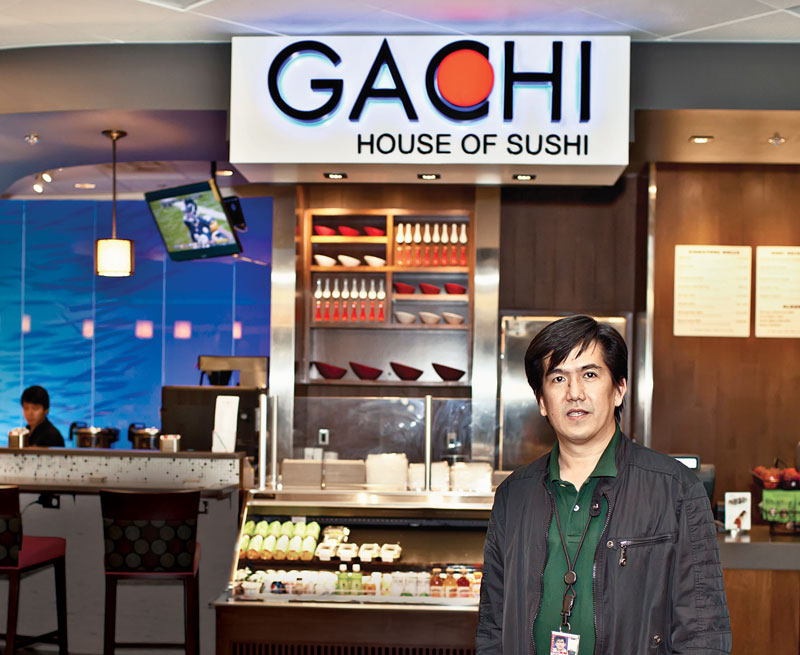Daniel Kurniawan started as a cashier with Arby’s in 1991, and remains with the brand today. He opened three Arby’s units in his home country of Indonesia—located in Surabaya City and Bali Island—in early 2000. Kurniawan now operates Arby’s units in Maryland and attributes much of his success to his location inside Baltimore/Washington International Airport (bwi), which brought in $2.5 million in revenue last year.
While posting strong sales numbers with Arby’s as a franchisee, Kurniawan started his own concept, Gachi House of Sushi, inside BWI last year. Gachi offers made-to-order specialty sushi rolls, signature dishes, wine, beer, and sake in a sit-down or grab-and-go format that’s perfect for busy travelers.
With two of his own branded units inside BWI and a third on the way, Kurniawan has developed Gachi from the ground up and hopes to begin franchising the concept in the near future. In addition, he has been able to transfer his experience as a franchisee into his own business.
Kurniawan explains how operators can use their business acumen and franchising experience to start their own brand, all while keeping their franchise profitable.
1. Figure out your customer base
Our Arby’s units were doing so well inside BWI that the airport staff approached us about offering up a different product to traveling customers. I never wanted to start my own brand as an act of rebellion to the big brands out there. In fact, it is because of my longstanding franchisee experience that I was able to do it in the first place.
Nonetheless, we wanted to develop something new and authentic for the customers and came up with the sushi idea. It was different enough from the surrounding brands.
More importantly, we knew what kind of market we were going into at BWI. Airport customers are so different than other market segments, and we needed to take advantage of their behavior and purchasing trends.
By starting my own brand, I have the liberty and freedom to be creative and try to capture customers more so than I do with a franchised brand.
The Gachi Sushi menu is a perfect example of this type of freedom; there are smaller-portioned plates, vegetarian options, gluten-free dishes, and others. I am able to diversify so much more in the menu and catch other customers who are looking for these options.
2. Separate yourself from others
The first step for me was to find out what customers I was missing at Arby’s. Where was someone else going rather than coming into one of my Arby’s locations? I needed to aim at that market segment that I was missing.
Once I was able to understand the customers I was missing out on, I was able to build my menu accordingly. The type of food was a healthy choice based on our segment of the marketplace. It’s something quick and healthier than other quick-service options at the airport.
I think if there are franchisees out there looking to start their own brand, they need to focus on a particular segment of customers that they are missing.
Obviously, I don’t want to offer a similar product to that of my Arby’s units, but it goes beyond that. The entire atmosphere, menu, and promotions need to be different and unique.
You get to literally build the entire brand, from the menuboard colors to the product descriptions. It’s a very liberating business venture, especially when you were franchising before.
3. Don’t be scared of the big boys
The No. 1 challenge for franchisees looking to do this is having to start out as the little guy in a huge, competitive business. We know that we are a small brand in a relatively small market compared with other types.
Sometimes it is difficult to have the same relationships with vendors or suppliers. But because I have my own brand now, I have the ability to exercise my own costs with different suppliers and I can be more specific.
Additionally, because we operate independently, my team is able to pay attention to the market a little more closely and adapt to it more quickly and without constraints.
I think that the overall profit turnaround in quick service is harder than it has been in the past, but having your own restaurant brand can really change that. You’re able to set everything up yourself and develop a concrete vision not for just one franchised unit, but for an entire concept.
Because of our liberties and ability to change our business as we see fit, I’m confident that we’ll have a better profit margin than that of a franchised unit.
4. Build it all and all at once
With a new brand, it needs to get off the ground as fast as possible. There won’t be any reinforcement help coming from the franchisor or a team of marketing experts to help you out with point of purchase. The customers have never heard of you, and that preparation has to be done correctly.
Get an operations manual together, and get it together fast. After that, every aspect of the brand needs to be in order, including your menuboard, presentation, staff, and every other part
of the business.
What is most important, though, is that you remain consistent. People will continue to pay attention to your brand and need a sense of familiarity.
It’s not good if you’re constantly changing the idea, food, and look of your brand when you’re just starting out. Keep it consistent and change what you need to change for the betterment of your business.










